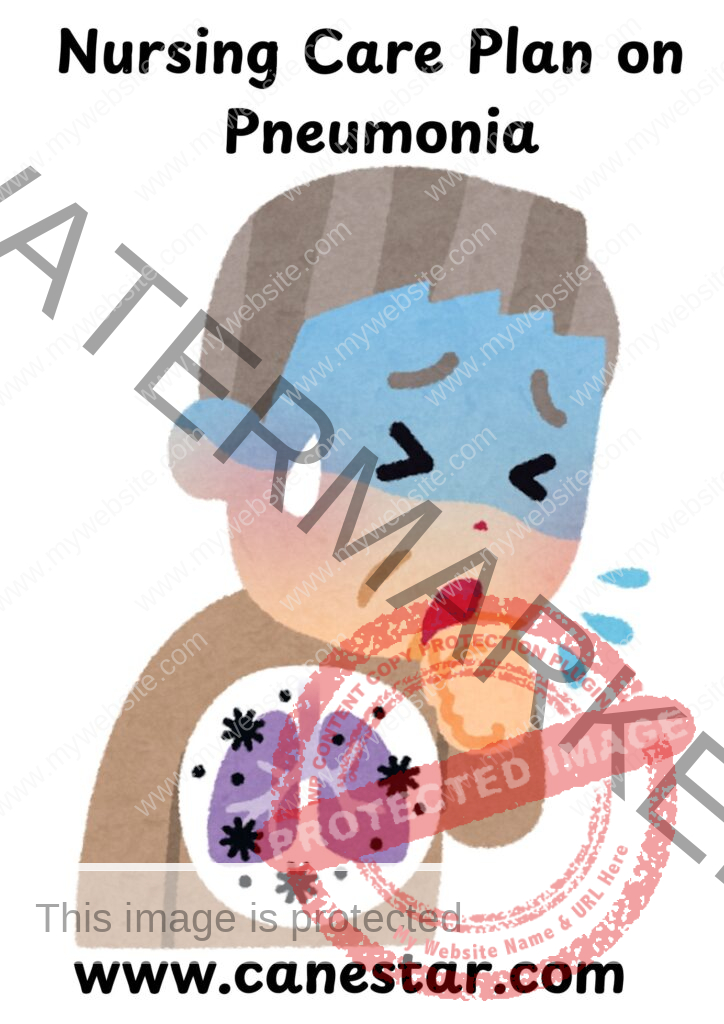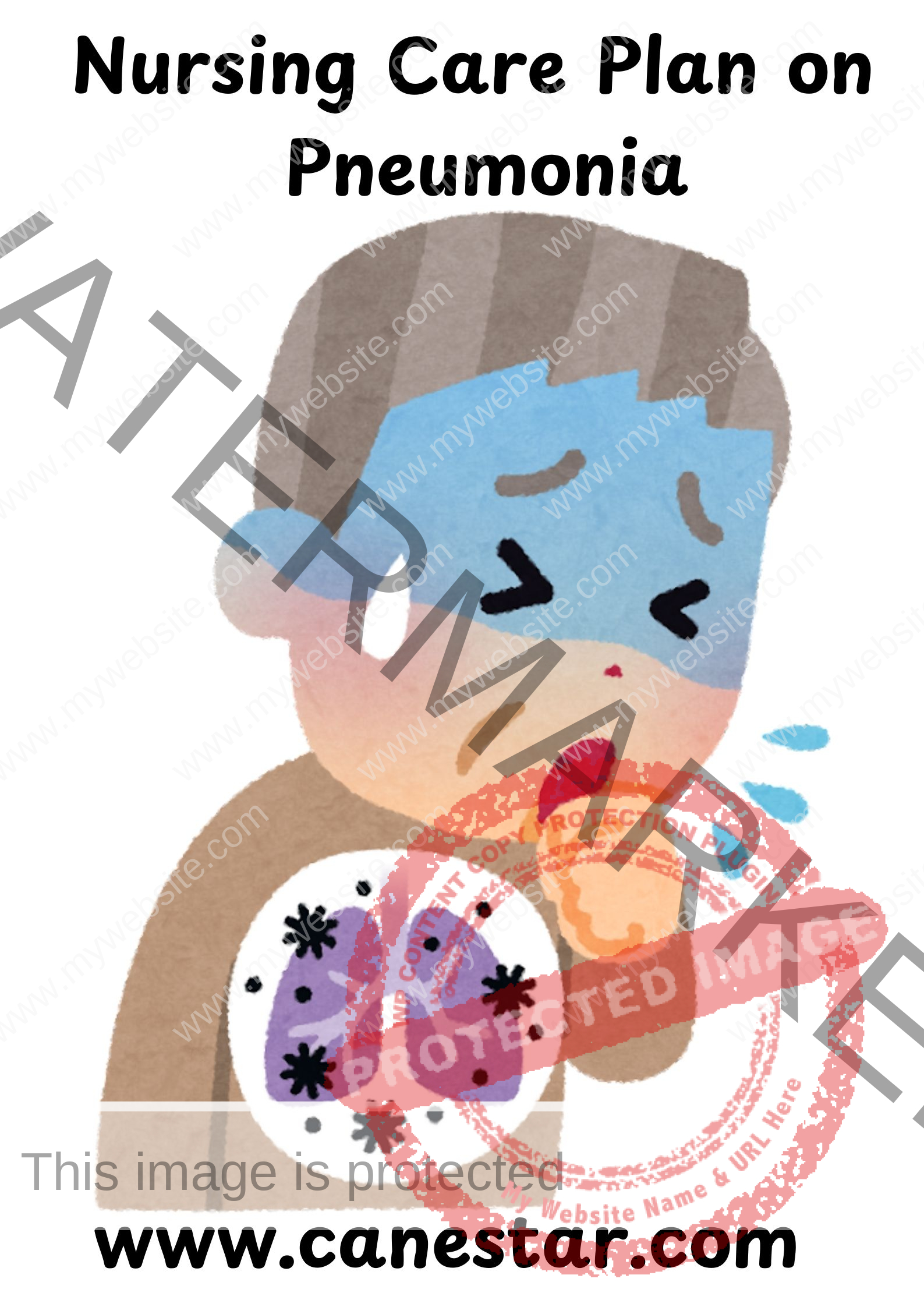NURSING CARE PLAN FOR PNEUMONIA
NURSING CARE PLAN FOR PNEUMONIA
NURSING CARE PLAN ON PNEUMONIA
Pneumonia
Definition: Pneumonia is an inflammatory condition of the lung, primarily affecting the alveoli. It can be caused by infections (bacterial, viral, or fungal) or non-infectious agents (aspiration of food or chemicals).
Types of Pneumonia:
Community-Acquired Pneumonia (CAP):
- Acquired outside of healthcare settings.
- Common pathogens: Streptococcus pneumoniae, Haemophilus influenzae.
Hospital-Acquired Pneumonia (HAP):
- Develops 48 hours or more after hospital admission.
- Often caused by multidrug-resistant organisms.
Ventilator-Associated Pneumonia (VAP):
- Occurs in patients on mechanical ventilation.
- Commonly associated with organisms such as Pseudomonas aeruginosa.
Aspiration Pneumonia:
- Results from inhalation of food, liquid, or vomit into the lungs.
- Can lead to anaerobic bacterial infections.
Causes of Pneumonia:
Bacterial Infections:
- Streptococcus pneumoniae, Staphylococcus aureus, Klebsiella pneumoniae, Mycoplasma pneumoniae.
Viral Infections:
- Influenza virus, respiratory syncytial virus (RSV), coronaviruses.
Fungal Infections:
- Histoplasmosis, coccidioidomycosis, cryptococcosis.
Non-infectious Causes:
- Inhalation of irritants, chemical fumes, or food.
Symptoms:
Respiratory Symptoms:
- Cough (productive or dry)
- Shortness of breath (dyspnea)
- Chest pain (especially with deep breathing or coughing)
- Wheezing
Systemic Symptoms:
- Fever and chills
- Fatigue and weakness
- Sweating
- Confusion (especially in older adults)
Risk Factors:
Age:
- Very young children and older adults are at higher risk.
Chronic Conditions:
- Asthma, chronic obstructive pulmonary disease (COPD), diabetes, heart disease.
Immunocompromised State:
- Conditions that weaken the immune system (HIV/AIDS, cancer treatment).
Smoking:
- Increases susceptibility to lung infections.
Recent Hospitalization:
- Higher risk for HAP and VAP.
Diagnosis:
Clinical Assessment:
- Physical examination (auscultation for crackles, decreased breath sounds).
- Assessment of vital signs (fever, tachypnea, low oxygen saturation).
Imaging:
- Chest X-ray: May show infiltrates, consolidations, or pleural effusions.
- CT scan may be used for further evaluation.
Laboratory Tests:
- Sputum culture: To identify causative organisms.
- Blood cultures: Particularly in severe cases.
- Complete blood count (CBC): To check for elevated white blood cell count.
Pulse Oximetry:
- To assess oxygen saturation levels.
Nursing Care Plan for Pneumonia
Patient Information:
- Name: [Patient’s Name]
- Age: [Age]
- Diagnosis: Pneumonia
- Date: [Date]
Nursing Diagnosis:
- Ineffective Airway Clearance related to inflammation and increased mucus production as evidenced by productive cough, wheezing, and abnormal lung sounds.
- Impaired Gas Exchange related to alveolar-capillary membrane changes and fluid in the lungs as evidenced by dyspnea, cyanosis, and low oxygen saturation levels.
- Activity Intolerance related to impaired oxygen transport and fatigue as evidenced by shortness of breath on exertion and increased respiratory rate.
- Risk for Dehydration related to fever, increased respiratory rate, and poor oral intake.
Assessment Data:
Subjective Data:
- The patient reports shortness of breath, chest pain, and a productive cough with green/yellow sputum.
- Complains of fatigue and difficulty completing daily activities.
- Reports a history of fever and chills.
Objective Data:
- Vital signs: Temperature: 38.5°C, Respiratory rate: 28 breaths/min, Oxygen saturation: 90% on room air.
- Auscultation reveals crackles and diminished breath sounds in lower lung lobes.
- Chest X-ray shows infiltrates consistent with pneumonia.
- Elevated white blood cell count.
Goals/Outcomes:
Short-term Goals:
- The patient will demonstrate effective airway clearance as evidenced by productive cough and improved breath sounds within 48 hours.
- The patient’s oxygen saturation will improve to >92% on room air within 24 hours.
Long-term Goals:
- The patient will maintain clear lung sounds and normal respiratory function by discharge.
- The patient will report increased energy and the ability to perform daily activities without excessive fatigue within one week.
Nursing Interventions:
Assess Respiratory Status:
- Monitor respiratory rate, depth, and effort.
- Assess for use of accessory muscles and listen for abnormal lung sounds (crackles, wheezing).
Rationale: Regular monitoring allows for early detection of respiratory distress and worsening of pneumonia.
Administer Oxygen Therapy as Prescribed:
- Provide oxygen via nasal cannula or mask as ordered to maintain SpO₂ > 92%.
Rationale: Oxygen supplementation improves tissue oxygenation and relieves hypoxemia caused by impaired gas exchange.
Encourage Coughing and Deep Breathing Exercises:
- Assist the patient with deep breathing and coughing exercises every 1-2 hours.
- Encourage the use of an incentive spirometer.
Rationale: Deep breathing and coughing help expand the lungs, clear secretions, and prevent atelectasis.
Position the Patient to Optimize Lung Expansion:
- Position the patient in a semi-Fowler’s or high-Fowler’s position to promote lung expansion and decrease the work of breathing.
Rationale: Elevating the head of the bed facilitates easier breathing and reduces pressure on the diaphragm.
Administer Medications as Ordered:
- Administer antibiotics, bronchodilators, and antipyretics as prescribed.
- Monitor for therapeutic and adverse effects.
Rationale: Antibiotics treat the infection, bronchodilators improve airway patency, and antipyretics reduce fever and discomfort.
Encourage Fluid Intake:
- Encourage the patient to drink 2-3 liters of fluids daily unless contraindicated.
Rationale: Adequate hydration helps thin secretions, making them easier to expectorate, and prevents dehydration from fever and increased respiratory effort.
Provide Rest Periods Between Activities:
- Encourage the patient to rest and limit physical activities that cause fatigue or dyspnea.
Rationale: Rest conserves energy and decreases oxygen demand, reducing the strain on the respiratory system.
Monitor for Signs of Complications:
- Assess for signs of worsening infection such as increasing fever, persistent or worsening cough, or pleuritic chest pain.
Rationale: Early detection of complications (e.g., pleural effusion, sepsis) allows for prompt intervention.
Educate the Patient on Proper Hand Hygiene and Respiratory Etiquette:
- Instruct the patient and family members on proper handwashing, coughing into tissues, and using masks to prevent the spread of infection.
Rationale: Pneumonia, especially in cases of viral or bacterial infections, can be contagious and requires infection control measures.
Provide Nutritional Support:
- Offer small, frequent, high-calorie meals to prevent fatigue and support recovery.
Rationale: Adequate nutrition supports immune function and tissue repair during the recovery process.
Evaluation:
- The patient’s oxygen saturation has improved to >92% on room air.
- Breath sounds have improved with diminished crackles, and the patient reports easier breathing.
- The patient is able to expectorate secretions effectively.
- The patient reports reduced fatigue and increased ability to participate in activities of daily living.
- No signs of complications such as sepsis or respiratory failure are noted.
Documentation:
- Date and time of respiratory assessments, including lung sounds, oxygen saturation, and respiratory effort.
- Details of oxygen administration and patient response.
- Medications administered, including antibiotics and their effects.
- Fluid intake and output, as well as signs of dehydration or adequate hydration.
- Patient and family education on pneumonia management and infection prevention.
Signature: [Nurse’s Name]
Date: [Date]


